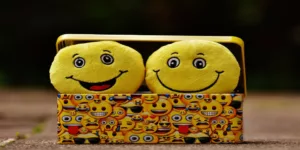Towards the end of 2017, the launch of Apple’s iPhone X got everyone talking, particularly the introduction of its “true depth camera”—technology which can unlock the phones through facial recognition. True depth is also responsible for another popular feature on the new iPhone: Animojis. This variation on traditional emoji uses technology known as augmented reality which, as developers REWIND explain it, “doesn’t create a 3D model of a space, but…realistically change the scale and perspective” of objects.
AR has already become a widespread phenomenon thanks to the Pokemon Go! craze of 2016, but by allowing users to make their own customisable versions of standard emoji, Apple are bound to take this technology to an even wider audience. According to New Scientist, 6 billion emoji (the plural of emoji is actually emoji) are sent between the world’s population on a daily basis, with nearly 2000 different icons to express oneself with. But how did emoji become so ubiquitous that one became the Oxford Dictionaries word of the year in 2015, and is there something they can tell us that mere words can’t?
Emoji are (almost) universal
Unlike verbal communication, the majority of emoji are comprehensible in any language; a smiley face denotes happiness wherever you are in the world. Translation firms, while unlikely to need to be interpreting these images any time soon, have noted that emoji are a valuable evolution in non-verbal communication, coming from what one agency calls “a long tradition…of ideograms or logograms,” which stand in for ideas and words respectively.
Emoji were included as part of the Unicode Standard character coding system in 2010, which is used on all text-based devices. While they were far more open to interpretation across different platforms (Samsung, Android etc), emoji are now becoming more standardised and, therefore, easier to understand. The first online emoji reference site, Emojipedia, was created five years ago, and remains the primary resource for those unsure about exactly what that aubergine they’ve been sent means.
Emoji speak louder than words
One major issue with text-based communication is that it removes any sense of nuance, particularly when it comes to sarcasm. A 2016 study outlined by Slate showed that emoji and punctuation, particularly ellipses and the wink emoji, are useful at emphasising any kind of irony in the written word. This is backed up by prominent British linguistics professor Sophie Scott, who told the Guardian in advance of her Royal Institution Christmas lecture that emoji are “trying to put that emotional, non-verbal information back in”.
While the old adage about 80% of communication being nonverbal doesn’t quite hold as true as we once thought, emoji have allowed the subtleties expressed through the spoken word to find their way into text. Emoji censorship has even become a hot-button issue, particularly in 2016 after Apple changed their gun emoji to a less-controversial waterpistol in the wake of increased gun violence in the United States.
Emoji are taking on their own meanings
Whilst the majority of emoji are self-explanatory, some have found their own alternative usage as a new, pictorial form of slang, and the internet is littered with articles dedicated to the real meanings of emoji. For example, the emoji depicting a goat is most frequently used as a mark of respect, as in “Greatest Of All Time”. One writer for New York Magazine recently highlighted the significance of the “100” emoji amongst the black community; popularised through Twitter, the icon has become shorthand for keeping it real, even though the origin of the image is based on getting full marks in a test at school.
The relative novelty of emoji as a method of communication has allowed for them to take on these new meanings, again proving their usage as ideogrammatic symbols. Now that Unicode are bringing more diversity to emoji, particularly with regard to gender and race (and redheads), people want to be portrayed as accurately as possible. So if emoji really is becoming a universal language, widening its level of representation will only serve to increase its significance.








